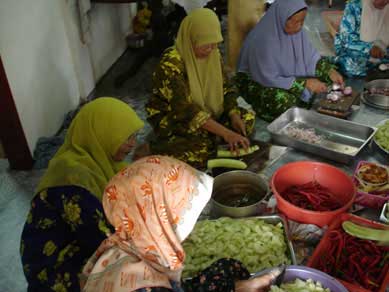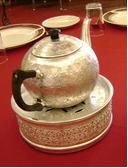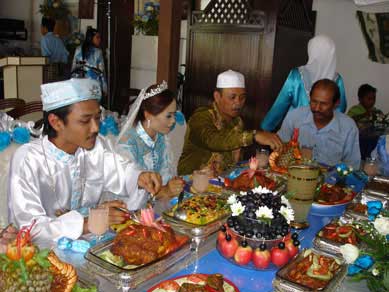
|
||
|
Follow @Nazlina
Malay Table MannersLike other races, Malay table manners is unique and the etiquette regarding food is also quite elaborate. Malay culture has a few ways of handling food which are still practised until today. There are rules and taboos that you must observe if you happen to be invited to a Malay home for a meal. Malays are also invariably muslims, therefore there is no pork, non-halal meat or alcohol beverages served in a Malay home.
I will cover the traditional ways of dining, modern ways of serving as well as the etiquette during the breaking of fast during Ramadhan. It is polite to bring a gift of fresh fruits to your host. This is called buah tangan. If it is a wedding reception at a village, it is nice to bring something sweet, like sugar, jelly or cakes in addition to your wedding present to the happy couple. It is also acceptable to give a gift of cash for the newlyweds, you place the money in an envelope and hand it to either parent of the bride or groom upon leaving. The envelope is slipped discretely into their hands when you shake them to congratulate them on their son's or daughter's marriage. Traditional Malay Table MannersTypical Malay village homes are built in stilt. They have a flight of stairs leading to the main hall. You are required to take off your shoes and clean your feet at the entrance. Most homes have a water pipe or a big earthenware jar called tempayan that holds water for the purpose. Traditional Malay feast is laid down on the floor. When all guests are seated facing a square piece of clothes called saprah (similar to a tablecloth but laid on the floor), food will be brought in.
Malay meals are not served in courses, rather, all food are presented at the same time. Using a small bowl with water or ketor (a jug with cleaning water, together with a big bowl to catch the remaining water), you dip the tip of all your right fingers for cleansing. The meal will be eaten with your right hand. Left hands should never be used to handle food at any circumstances. The main dish will be rice, there will be three or four side dishes that go with the rice. Dishes with kuah will have a spoon for your to scoop the sauce, soup or gravy but for dry dishes, you simply tear a piece of the food with your right hand from a communal dish. Normally, female guests and children will be served on a separate saprah than from the men. The exception will be if the couple in question are honored guests or it is a small private affair. The way men and women sit are notably different. Men crisscross their feet in front of them - bersila. Women fold both their feet on one side - bersimpuh (normally on their right side). For those who are not used to this manner of sitting, it can be quite uncomfortable. Some rules regarding Traditional Malay table manners
Now, let's cover modern Malay table manners.
Modern Malay Table MannersNowadays, most Malay homes have normal dining table and chairs but still, the basic etiquette is still followed, especially regarding the respect of food. You will be served with a pair of fork and spoon but not dining knives. However, some Malay families adopt elaborate western ways of dining, you would be wondering if you have entered an English home by mistake! Now, let us cover finger food, snack and rules during teatime.
There is a story behind this. It was said that the young lady who took the last piece of food on the plate would never get her match in marriage. Hence, the invention of this rule. However, the real reason is, the young lady should think of others before taking that last piece of food for herself. Malay Table Manners During Breaking of Fast (Buka Puasa)Sometimes, non-muslims are also invited for buka puasa. This is just an example of the hospitality offered by gracious Malay hosts. Buka puasa commences as soon as the sun goes down. The time can be found out by daily almanac and will be broadcast by the muezzin from the mosques.
According to Islam, during breaking fast, you should only consume a little of food. After the Maghrib prayer only then you may eat the full meal. This makes sense because you will get stomach upset if you do not do so. However, it takes a lot of willpower to follow the teaching to the letter. A lot of people cannot wait to finish the big meal in one sitting. I hope my explanation above will be helpful for you to understand more about Malay table manners and also Malay culture in general. It is nice to learn about other common practices around the world. You will never know when you will be invited to dine at a Malay home. Go to the page of Malay Proverbs Back to the Malay Traditional Food page Back to the homepage of Pickles and Spices

Custom Search
|

Custom Search
Nazlina's Cooking Class in PenangAttend my cooking class to learn making traditional food.
The morning class includes Penang Market Tour.
PLEASE NOTE: We now offer PM classes, for vegan and vegetarians. After reading about Malay Table Manners, why not learn some interesting Malay Proverbs? |
|
|
|
||
|
|
||






New! Comments
Have your say about what you just read! Leave me a comment in the box below.